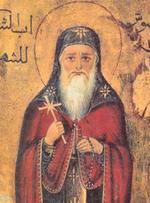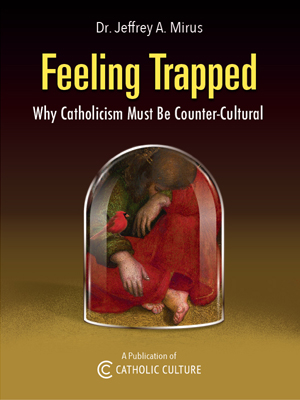Resurrection Theory II: Did Our Lord Die or Swoon?
By Dr. Jeff Mirus ( bio - articles - email ) | Apr 12, 2006
In last week’s column, I noted that eighteenth century rationalists made a new effort to explain away the Resurrection while still accepting the fact that Christ’s tomb was empty after the third day. This alternative theory posits that Christ did not actually die on the Cross. Rather, he fainted and appeared dead, but was buried alive. Later he revived, escaped from the tomb, and appeared to his disciples, giving rise to the Resurrection Myth. How plausible is this theory?
The Certainty of Christ’s Death
The easiest way to refute this “swoon theory” is simply to establish the certainty of Christ’s death. The historical record is very precise about the sufferings Jesus was forced to undergo. First, he was scourged as an example to others. This would have been done using the flagrum, leather straps embedded with bits of bone or metal. There was no prescribed limit for Christ’s offense, which was unknown in Roman Law. The beating was undoubtedly brutal, laying bare the veins and muscles, and perhaps even the bowels.
In this weakened condition and having already lost so much blood, Jesus was forced to carry the horizontal timber of his cross for a considerable distance, up the hill to Golgotha. The weight of this timber would have been about 70 pounds, causing Our Lord to fall several times under its weight, until a bystander was pressed into service to complete the journey. Then, although criminals were sometimes tied to their crosses, Our Lord was nailed to his cross through both his feet and either his hands or wrists. The pain alone was unspeakable, the loss of blood extreme.
Crucifixion causes death in several ways. In addition to the long torment and shame, Jesus would have experienced dizziness, cramps, thirst, traumatic fever, tetanus, gangrene, and asphyxiation. In addition, a soldier put a lance into his side, opening a hole from which flowed first blood then water. According to medical diagnosticians, this sequence signifies rupture of the heart, a certain cause of death.
Betting on the Incredible
The lance thrust not only made Our Lord’s death medically certain but, in fact, was designed to do so. Pilate wanted to ensure that there was no doubt about Christ’s death before the body was released. In addition, the Jewish leaders would obviously have made sure that Jesus of Nazareth was dead. Moreover, Joseph of Arimathea would hardly have buried Our Lord in his own tomb if he were not certain the end had come, nor would the women have prepared his body for burial. In fact, it took over 1700 years for anyone to question whether Christ had really died. No one doubted it at the time.
As if all this is not preposterous enough, consider what else the swoon theory requires. Even if Jesus were barely alive, he would have had to revive sufficiently in the stone-cold tomb overnight to remove his grave clothes, an impossible task for even a healthy man because they were stuck on with myrrh, which rapidly hardens into a sort of glue. Presumably he also found sufficient energy to fold up the grave clothes neatly and lay them aside. In any case, he would have had to roll away (uphill) the huge stone covering the entrance of the tomb, a task which three healthy women knew they could not perform.
Once outside the tomb, Christ would have had to fight off the guard, walk miles on wounded feet, and finally convince his disciples that he had conquered death. Yet the disciples did not describe Christ as merely revived or resuscitated. They saw a glorious Christ, no longer bound by time and space. St. Paul described him with the word egegertai, which indicates a return to life free from corruption. This was not a walking corpse.
The Cult of Christ’s Tomb?
If Our Lord had merely swooned and revived, he would nonetheless have died eventually. In light of the tremendous following he had and the subsequent rise of the Christian faith, the ultimate grave site of the Founder would have become a beloved shrine. One need only consider Christian veneration of the saints. How prized would Christ’s own remains have been! But there were no remains: not then, not ever.
It is perhaps for this reason that one of the most popular representations of the swoon theory in modern literature, Hugh Schonfield’s The Passover Plot (1965), combined it with the theft theory. Schonfield argued that the disciples conspired to chemically induce the swoon, assist Jesus in his escape from the tomb, and perpetrate the Resurrection Hoax. This inventive theorizing, of course, has the dubious claim of running afoul of the objections to both explanations at the same time.
Did Our Lord Lie?
In general those who wish to discredit the Resurrection are willing to admit that Christ was, at least, a great teacher and a man of unparalleled integrity. It is interesting to note, therefore, that while the theft theory (considered last week) assumes that the disciples lied, the swoon theory assumes that Jesus Christ himself lied. This is contrary to what even non-believers see as the overwhelming evidence of his life and work. It adds to both the indignity and the foolishness of those who refuse to take history seriously.
As I mentioned in my previous column, only those theories which account for the emptiness of the tomb really deserve a hearing. Nonetheless, we will consider in the next installment two final theories which dispense with facts altogether, attempting rather to reinterpret the disciples’ experience at a distance. Thus we will close our consideration of alternative Resurrection theories with a look at collective hallucination and religious symbolism next week
All comments are moderated. To lighten our editing burden, only current donors are allowed to Sound Off. If you are a current donor, log in to see the comment form; otherwise please support our work, and Sound Off!








